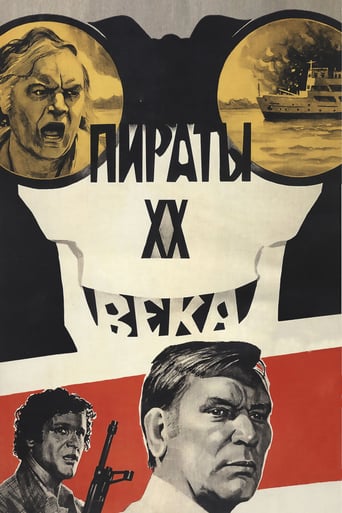Kirpianuscus
The basic temptation - to compare it with the American hijaking films. the basic sin - to ignore the context when it was made. and, not the last, to ignore the story. sure, many cliches. and fight scenes. and the brave sailors . but the film is more than part from a too familiar series. it is nice, unrealistic - so amusing, chaotic and full of precise pieces of Soviet entertainment . result - its succes. and the perspective from today about a new tool of propaganda in Brezhnev era.
hte-trasme
This film was very successful when it came out, for reasons that also make it difficult to evaluate in a vacuum today. In 1979 action'adventure films with Kung Fu were something new in Soviet cinema, and this example caused a sensation. There's even a sense that the filmmakers new this is all they had to do -- the movie has manifestly no designs on a complicated plot or characters, or on anything other than being a straightforward, fast-moving crime film. It almost seems to be shooting at being a plain, unadorned, platonic example of a genre film, which makes it suit nicely the needs of an introduction to Soviet action thrillers, but ensures it doesn't seem like anything special in comparison with similar films of other countries and/or future years. While it presents something new in the realm of contextualized genre for its viewers, it relies on some very old tropes and some rather imperialistic views of island life, and generically-drug-related international criminals. It's also surprisingly open in its violence, with people shown being shot, burned, and tortured quite unflinchingly. This against a rather idyllic-looking spotless blue sea. On it's own, this movie doesn't seem like much apart from easily- digested but insubstantial light action such as may have been produced anywhere, but the fact of its release and success in context give it some historical interest as well.
SMalamud
The Pirates of the XX Century is a romantic action-adventure thriller, which explores eternal themes of naval folklore: kung-fu and male bonding. According to many film critics of the time, it was the first but sadly not the last attempt of Soviet movie makers to convincingly portray complex philosophical dilemmas associated with kicking other human beings into the facial and reproductive areas. It does however manage to rate far above similarly themed American masterpieces, such as Rambo, Delta Force and Home Alone. The plot of the film focuses on a Soviet merchant marine vessel, which is attempting for the purposes of world peace to transport a cargo of narcotics into the Motherland. It is implied that the drugs are to be used by the Soviet government for noble and humane causes, such as perhaps to keep dissident scientists in prison "clinics" on their best behavior. However complications soon arise. This happens to the great surprise of Soviet viewers, who were fully expecting the vessel to complete its journey safely and uneventfully and end the film with a rousing speech at the local Party committee in the port of their destination. It is not to be so. The vessel is attacked by capitalist bandits who appear to have skills in forbidden and inhumane "karate" fighting and have facial features similar to those of the natives of Tajikistan. The Soviet audience is left to guess about what these "pirates" goals might be. They may or may not have something to do with the narcotics. This, however, becomes completely secondary when the vessel's radioman is dispatched by means of an axe, providing for a full-year's worth of arguments among Soviet schoolchildren on whether the actor was actually killed in that scene. (Red liquid was clearly visible in the shot, covering the unfortunate radio specialist's face.) The conflict of two completely different social systems and schools of judo follows. For some, completely unexplained, reason this happens near an island whose entire population consists solely of photogenic women of vaguely Uzbek appearance. As the suspiciously Tajik-looking "pirates" seize the vessel, a series of talks between them and the crew commences, though the purposes of this lengthy exchange are never quite clear. Apparently, the Soviet captain is trying to either appeal to the "pirates" better nature or to blackmail them with something. The Uzbek women, meanwhile, tell the crew the sad story of their occupation and enslavement by the "pirates". The crew listens in between short and purposeless skirmishes with the enemy, as more high kicks and grunts are displayed to the overwhelmed viewers. Eventually, perhaps growing tired of the strange script, the Soviet captain tries to escape, leaving the vessel and its precious cargo in the capitalist hands. This does not end successfully however as the "pirates" chase the crew's lifeboat down. Seeing that all the possible options have been exhausted, the captain decides on the last desperate measure: he orders a curly-haired engineer named Seryozha to take off his shirt and beat everyone up. Which Seryozha, right after chastely kissing a bespectacled female accountant on the cheek, duly does, utilizing the best of the Soviet SAMBO combat technique. Unsurprisingly, it also involves a fair amount of kicking. As all the "pirates" are lying around dying of shame, the film concludes with a happy ending. Except for the Uzbek women, whose fate remains a mystery. The moral however is quite clear: do not trust the evil Tajiks.
jfirst
_Pirates of the XX Century_ was (and is) the highest grossing film in Soviet Russian history. It was released in 1980 and reflected growing interest not only in American and Hong Kong film genres like action and martial arts, but also a desire to see other, more exotic, locations than were physically possible for average Soviet citizens. From the perspective of someone living in the year 2003 and continually bombarded with action-adventure blockbusters that contain nothing apart from advanced special effects, this movie is not incredibly successful. The historical context of the film is absolutely necessary to understand why this film was so radical and so popular in its time and place. Soviet cinema in the 1960s and 1970s was a high art cinema by and large, and was only marginally geared toward so-called popular tastes. _Pirates_ dispensed with narrative development almost entirely, and was more interested in action sequences, the iconography of which attempted to touch upon adolescent fantasy. On another level, the Soviet government's allowance of this film to be made represents greater attention to the profit-making potential of cinematic products. Thus, the appearance of _Pirates_ indicates a certain transformation of notions of the enlightened Soviet film spectator toward a conception of the film-goer as consumer, much as is consistent with views in capitalist countries. In any case, this film is certainly worth your time if you have any interest in the cultural politics of the former Soviet Union


 AD
AD



